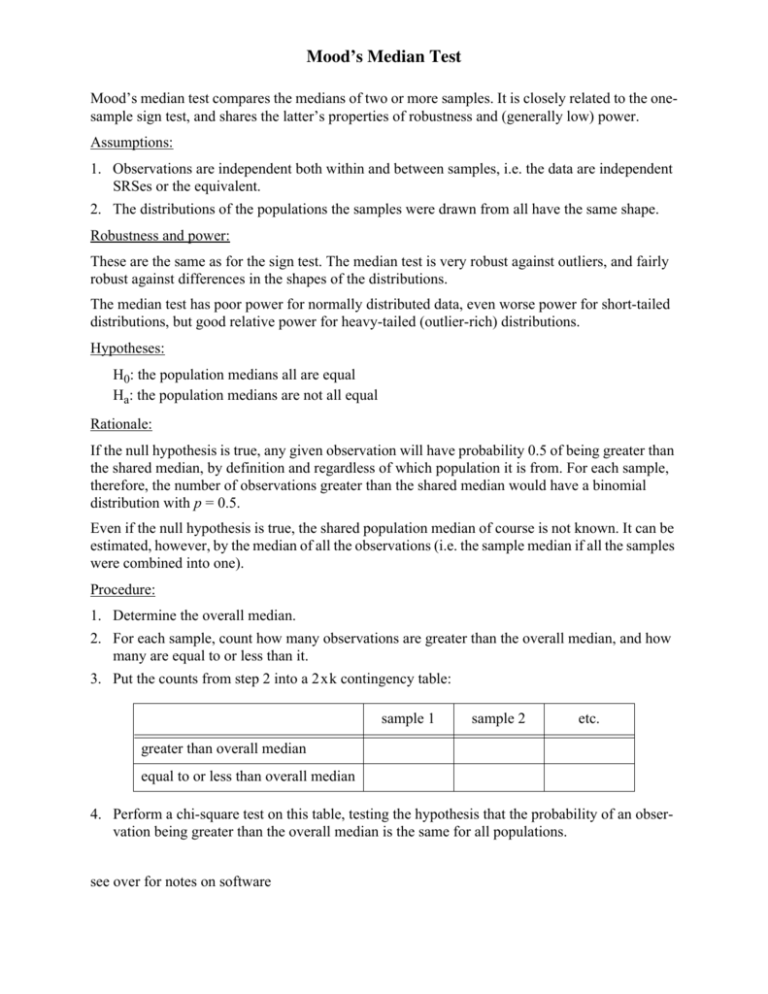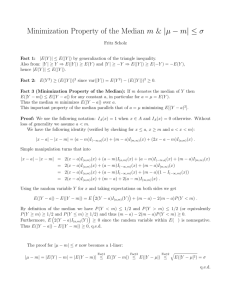Mood`s Median Test
advertisement

Mood’s Median Test Mood’s median test compares the medians of two or more samples. It is closely related to the onesample sign test, and shares the latter’s properties of robustness and (generally low) power. Assumptions: 1. Observations are independent both within and between samples, i.e. the data are independent SRSes or the equivalent. 2. The distributions of the populations the samples were drawn from all have the same shape. Robustness and power: These are the same as for the sign test. The median test is very robust against outliers, and fairly robust against differences in the shapes of the distributions. The median test has poor power for normally distributed data, even worse power for short-tailed distributions, but good relative power for heavy-tailed (outlier-rich) distributions. Hypotheses: H0: the population medians all are equal Ha: the population medians are not all equal Rationale: If the null hypothesis is true, any given observation will have probability 0.5 of being greater than the shared median, by definition and regardless of which population it is from. For each sample, therefore, the number of observations greater than the shared median would have a binomial distribution with p = 0.5. Even if the null hypothesis is true, the shared population median of course is not known. It can be estimated, however, by the median of all the observations (i.e. the sample median if all the samples were combined into one). Procedure: 1. Determine the overall median. 2. For each sample, count how many observations are greater than the overall median, and how many are equal to or less than it. 3. Put the counts from step 2 into a 2xk contingency table: sample 1 sample 2 etc. greater than overall median equal to or less than overall median 4. Perform a chi-square test on this table, testing the hypothesis that the probability of an observation being greater than the overall median is the same for all populations. see over for notes on software Minitab: Stat ⇒ Nonparametrics ⇒ Mood’s Median Test … Specify the columns containing the Response: (the quantitative variable) and the Factor: (the categorical variable defining the groups). No graphs are available; the only options are to Store residuals and (if residuals are being stored) to Store fits. S-Plus: This test is not directly available in S-Plus. It can be implemented as follows: 1. determine the pooled median: stack the samples and use Statistics ⇒ Data Summaries ⇒ Summary Statistics… 2. count the number of observations in each sample which are greater than the overall median determined in step 1, and the number that are equal to or less than it: for small data sets simply sort the data and count; for large data sets Data ⇒ Subset… can be used to create a column describing whether an observation is above the pooled median or not. 3. Do a Fisher’s exact test or a chi-square test on the table of counts from step 2 (or for large data sets, using the grouping variable and the subsetting variable created in step 2). For details see the S-Plus "How to" handout. Mood’s Median Test 2 of 2





